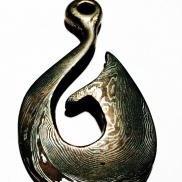-
Posts
1,081 -
Joined
-
Last visited
-
A Blacksmithing Primer Author; Randy McDaniel ISBN 9781737604495 174 pages. I really appreciate the truth in advertising with this book, it really is a primer and a good one at that. It won’t overwhelm with difficult concepts, but will help with so many details of the craft that a beginner would need for success. With hundreds of clear drawings to illustrate the text there is no room for confusion over what is being taught. It starts with covering the basic tools setting up a shop and then adds instructions for the different hammer blows and solid fuel fire advice. Then straight into projects including both fun items and ones every beginner needs, like tools and tongs. Round it all out with some welding pointers and you have a very functional primer from a former lecturer and demonstrator for ABANA meetings with +50 experience.
-
The New Spruce Forge Manual of Locksmithing: A Blacksmith’s Guide to Simple Lock Mechanisms Authors; Denis Frechette and Bill Morrison ISBN 9781733325004 304 pages. As Blacksmiths many of us take pride in having a wide grasp of the methods and procedures required to make items and make them function well. The New Spruce Forge Manual of Locksmithing offers many new skills for your own projects while you work your way through examples of classic locks. From a dead simple pipe lock to nifty trunk and gate locks. I was very excited to get my hands on this book. It opens with a few short sections of basics to help a complete neophyte be successful, but the bulk of the book jumps right into the meat and potatoes a Blacksmith needs to know for making locks, giving us not only dimensions but also shows you ways to build to and maintain the precision needed for success. One of the co-Authors of the book was well known to me because of his small You-Tube channel “DF in the shop”. Dennis’ channel is well worth subscribing to and includes some contents on locks as well as lots of great advice on Blacksmithing in general. My Honest opinion is that if you took the time to read a review on this book it would likely be a great addition to your library and well worth the time if you would like to add some locks to your lineup of products you can offer.
-
- denis frechette
- locksmithing
-
(and 1 more)
Tagged with:
-
This is all just based on my personal experience, which very clearly is much less important than your personal experience. I obviously am not going to convince you of anything so I am done discussing it with you. To anyone else reading this I urge you to think about what we KNOW carbon does when it is in solution with iron. The melting point gets lowered with increasing carbon. So common sense should make any reasonable person consider that it may have an effect to the faces of a weld joint as well.
-
Lol, we are all nitpicky in one way or another. I know I may not convince anyone to try out what I am saying, and that is fine by me. I think that sadly they are missing out on something good. As for item number one you are completely missing the point here. I am not trying to add carbon to the metal, just the weld joint. No need for special conditions or lots of time as the carbon only needs to react with the first atomic layer in the weld. Also, just to be clear I didn't quote You Tube, so please don't lump me in with the jumble of idiots out there. It honestly may NOT be a good idea for you, especially in a coke forge. But why try and stop anyone else from trying it in a propane forge? The reasons for trying it are sound, even though it doesn't seem beneficial to you.
-
My intent with adding a carbon source to flux was based on a couple things. 1. Carbon lowers the melting point of iron (and thus the welding point as well). I can't say a knife maker would care to do that, but to someone welding mild steel it could be very handy. 2. Carbon bonds with Oxygen, if you are trying to insure that a joint has no free oxygen to make scale then why would you not add it? The tiny little bit of ash in charcoal is likely less of a problem than all the old scale, rust and crud that many of us successfully leave in our welds anyway. 3. I run propane. Adding carbon to flux in a coke fire would seem pointless to me as well. Even though I can tune my burner for welding there is a LOT of poorly running propane forges out there. Many shipped new from the factory with terrible tuning. Adding a little insurance for newbies and people not inclined to tune a burner seems like a kind thing to do without causing much of a problem that I can see. Even running a well tuned propane forge I was never able to get leaf spring to weld to itself until I tried adding charcoal dust. It seems to me that making personal observations is one of the cornerstones of the scientific method. I feel sorry for anyone that feels they need to discount someone else's off hand and without any experimentation, as they are doomed to follow the crowd their whole life.
-
I honestly have not fire welded much recently. I played with the ratio a bit and found I could lower the charcoal dust percentage and still have it work well. It worked very well for welding leaf spring to itself, which is typically really hard to do. Give it a try, just make sure the charcoal is DUST and add some boric acid to help wet it. On the topic of metal bits in flux, I like many don't find the idea appealing. But It should be noted that cast iron powder would typically have a lower melting point than steel. I have always suspected that "iron fillings" in good flux that worked was actually cast iron that lowered the melting point at the weld by adding carbon. It also would scavenge excess oxygen. It has been on my radar to play with, just no time for it recently. Seems like a reasonable thing to try with anhydrous borax. Ps JHCC, if I didn't mention it before your original posting here on borax has to be one of the absolute best, most accurate and useful posts on all of IFI.
-

A New(?) Method for Drawing Spirals
teenylittlemetalguy replied to JHCC's topic in Blacksmithing, General Discussion
LOL, now that is a positive comment! -

A New(?) Method for Drawing Spirals
teenylittlemetalguy replied to JHCC's topic in Blacksmithing, General Discussion
Here is my favorite tidbit. Mathematician James Grime of the YouTube channel Numberphile has determined that 39 digits of pi—3.14159265358979323846264338327950288420—would suffice to calculate the circumference of the known universe to the width of a hydrogen atom. -
We are getting into the spirit of it this morning! Early September snow for the last day of summer... I am going to be making little fish shaped wall hooks for everyone.
-
I do have to say that I honestly didn't expect that...8-)
-

Palmgren anvil vise?
teenylittlemetalguy replied to SMP's topic in Anvils, Swage Blocks, and Mandrels
Thanks man! I like how the water comment went straight to single malt, been way to long for me. I think it would go well with a campfire as well since its always a good place for coming up with ideas. -

Palmgren anvil vise?
teenylittlemetalguy replied to SMP's topic in Anvils, Swage Blocks, and Mandrels
8-) Made my day. thanks! -
I don't think you will find an easy way to forge a blind square hole and keep the sides parallel. how about punching and drifting the hole in some stock and then arc welding it to a fancy handle?
-
teenylittlemetalguy started following Mokume in a kiln?
-
What I am describing is actually a solid phase weld. There is so much more control in a kiln you can do a better job keeping things from melting ( and thus blurring the boundaries.) so you get a much higher quality product. A weight applied while heating would just soak up the heat, slowing you down. Clamps are easy and there is a side effect most people don't think about, which is that Copper expands more than steel when you heat it so your clamp effectively gets tighter when you heat it. Some people take this idea to extremes by using extra low expansion metals as the bolts of the clamp.

